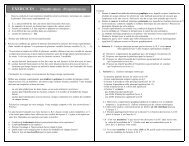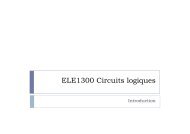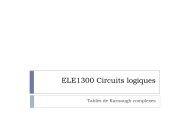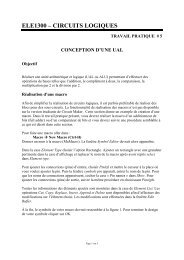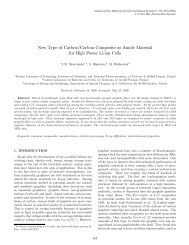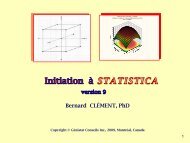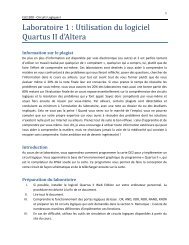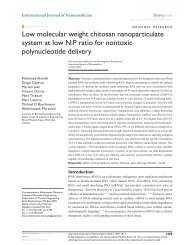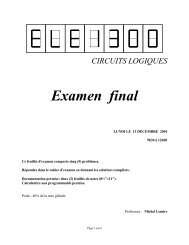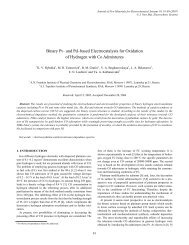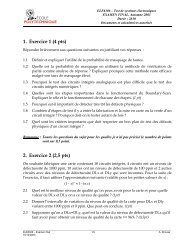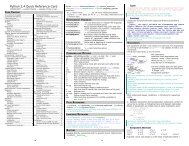Thermodynamics and Transport Model of Charge ... - IEEE Xplore
Thermodynamics and Transport Model of Charge ... - IEEE Xplore
Thermodynamics and Transport Model of Charge ... - IEEE Xplore
Create successful ePaper yourself
Turn your PDF publications into a flip-book with our unique Google optimized e-Paper software.
BOULAIS et al.: THERMODYNAMICS AND TRANSPORT MODEL OF CHARGE INJECTION IN SILICON 2729<br />
Fig. 1. (a) Schematic <strong>of</strong> a ring oscillator composed <strong>of</strong> four inverters <strong>and</strong> an AND gate. All inverters are equidistant to the target. (b) Typical result <strong>of</strong> the FVC<br />
output after a 950-mW 100-ns pulsed laser irradiating the center <strong>of</strong> the ring oscillator situated at 30 μm.<br />
II. EXPERIMENTAL SETUP AND RESULTS<br />
As described in [10], the sensitive circuits used to detect<br />
injected charges in the experimental work are CMOS ring<br />
oscillators, manufactured by TSMC in a 0.18-μm technology<br />
that has a low-resistivity p-type substrate. Oscillating at a<br />
stable frequency, the ring oscillator, as previously presented by<br />
Wild [10], is composed <strong>of</strong> four inverters <strong>and</strong> a gating NAND acting<br />
as an inverter during the oscillation operation. A frequencyto-voltage<br />
converter (FVC) is used to drive the chip output at<br />
a voltage that represents the oscillator’s frequency, as shown<br />
in Fig. 1. The on-chip oscillation <strong>of</strong> about 380 MHz is first<br />
divided by eight using a frequency divider (FD), then each<br />
period is converted by the FVC to a dc voltage that drives the<br />
output <strong>of</strong> the chip through an analog buffer. The laser target<br />
is a laser diffused resistor (LDR) implanted in the center <strong>of</strong><br />
the ring oscillator <strong>and</strong> located at various distance d to the<br />
ring oscillator, ranging from 20 to 40 μm. A test setup has<br />
been developed as described in [10] using a frequency-doubled<br />
continuous-wave Nd:YAG laser (532 nm) having an adjustable<br />
diameter <strong>and</strong> power. A pulse is selected from the continuous<br />
beam using an acoustooptic modulator <strong>and</strong> is focalized on<br />
the target. In all experiments, a single pulse is used with a<br />
pulse duration <strong>of</strong> 100 ns. The beam diameter is about 7 μm,<br />
<strong>and</strong> the emitted laser power P L is varying up to 1.5 W. Note<br />
that, throughout the text, the emitted laser power refers to<br />
the average laser power <strong>of</strong> the continuous-wave laser, taking<br />
into consideration losses due to the acoustooptic modulator.<br />
It is difficult to evaluate the optical losses due to the multiple<br />
reflections <strong>and</strong> the absorption in the interdielectric layers;<br />
the exact laser power arriving on the silicon is not known.<br />
A typical FVC variation for P L = 950 mW <strong>and</strong> d = 30 μm<br />
is given in Fig. 1(b). The measured maximum <strong>of</strong> the FVC<br />
output variation [FVCOV max defined in Fig. 1(b)] is shown in<br />
Fig. 2 as a function <strong>of</strong> the laser power P L . Estimations based<br />
on diffused-resistor creation experiments <strong>and</strong> in situ reflectivity<br />
measurements give a value for the melting power threshold <strong>of</strong><br />
around P L,th−m =(1.1 ± 0.1) W. One can distinguish three<br />
main regions in these measured results: 1) In the first region,<br />
for P L < 0.375 W, the FVC output increases with P L ;2)in<br />
the second region (0.375 W 0.7 W), the FVC output increases slightly with scattered<br />
results. An increase in charge injection with increasing power<br />
was expected. The presence <strong>of</strong> region II was not expected.<br />
To explain these results, the effects <strong>of</strong> heating on the charge<br />
transport must considered.<br />
III. CONSTANT-TEMPERATURE ELECTRONIC<br />
TRANSPORT MODEL<br />
Many models describing the interaction between a laser pulse<br />
<strong>and</strong> a semiconductor developed over the past four decades focus<br />
on emulating the impact <strong>of</strong> single-event effects by ionizing<br />
radiation on static memories [9], [11], [12]. In these existing<br />
models, relatively low laser powers are assumed, as any heating<br />
phenomena are excluded from the calculation. However, the<br />
laser used for creating LDRs is different in terms <strong>of</strong> power<br />
level <strong>and</strong> pulse duration, since significant heating <strong>and</strong> melting<br />
<strong>of</strong> silicon is required. As a first approximation, the substrate’s<br />
temperature was assumed to remain constant throughout the<br />
process. It will be shown that this assumption is not accurate.<br />
It is important to note that the laser is not directly focused<br />
on the active area <strong>of</strong> a transistor under test, but rather on the<br />
LDR region, which introduces additional specificity into the



